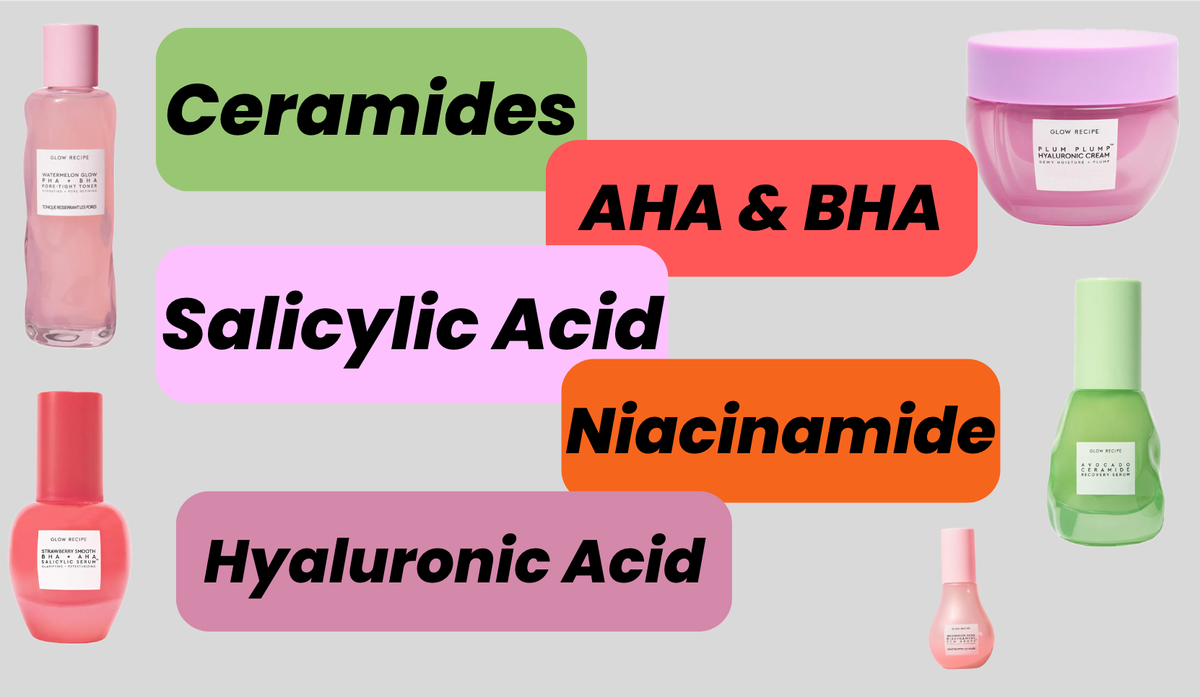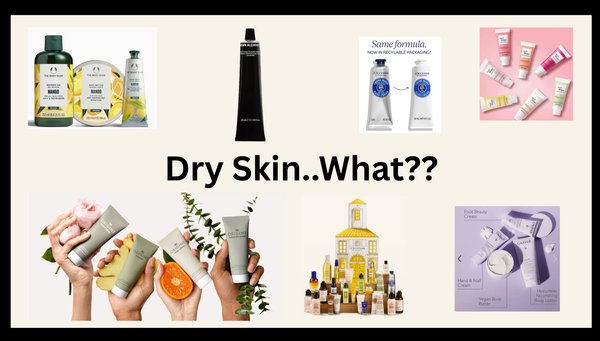Which Ingredients in GLOW RECIPE Products Actually Work?
Glow Recipe is a Korean-Beauty brand. Most of its products are named after their main active ingredient. In this article, we check if the ingredients in these products actually work based on science?

Glow recipe is one of my favorite skincare brands. This brand is known for its iconic fragrances, especially the watermelon line. Their products smell like literal fruits!
Some people criticize this brand and claim that all their products are just perfume in a bottle. However the brand claims that the fragrance is less than 0.5% of their formulations.
One very interesting and unique thing about this brand is that they have named different products after different active ingredients.
In the above add for example, they claim that different ingredients in their products perform the following functions:
Ceramides: Support a healthy looking skin barrier
AHA and BHA: helps to minimize the look of pores and hydrate the skin
Salicylic Acid: Smoothes the texture and helps clear out the breakouts
Niacinamide: brightens skin instantly and overtime
Hyaluronic acid: Plumps, hydrates, and give a dewy glow to the skin
Let's delve into these claims in detail and see if they are backed by science.
1. Ceramides
Skin that has aged over time typically has less amount of lipid in the epidermis (upper most layer of the skin), leading to dehydration and changes in the skin barrier. The aged skin becomes dry and flaky. This dry skin usually causes itching, and in some cases, lead to cracks and fissures.
Ceramides are a type of lipid (fat molecule) naturally found in the outermost layer of the skin, known as the Stratum Corneum. They play a crucial role in maintaining the skin's barrier function, which helps to retain moisture and protect against environmental irritants and pathogens.
Ceramides help to reinforce the skin's natural barrier by filling in the gaps between skin cells, thereby preventing moisture loss and keeping irritants out. A compromised skin barrier can lead to dryness, sensitivity, and other skin issues.
By retaining water in the skin, ceramides help to keep the skin hydrated and plump, reducing the appearance of fine lines and wrinkles.
Moreover, Ceramides act as a protective barrier against environmental aggressors like pollution, UV rays, and harsh weather conditions, which can cause premature aging and damage to the skin. (Elias, 2005 and Draelos 2008)
2. AHA and BHA
Alpha-hydroxy acids (AHAs) and beta-hydroxy acids (BHAs) are derivatives of Carboxylic acid (R-COOH). They are chemical exfoliants. They work by removing the upper most layer of dead cells from our skin.
AHAs can be further divided into different types, each having specific benefits as skincare ingredients.
Glycolic acid: Derived from sugar cane, very small in size, easily penetrates the skin, rejuvenates and improves the overall skin texture. Works great in treating acne.
Lactic acid: Derived from milk or fermented plant products. Gentle exfoliant and compatible with sensitive skin, making the skin smooth and radiant.
Citric acid: Derived from citrus fruits, antioxidant in nature, improves skin brightness and texture.
AHAs and BHAs also work great in treating hyperpigmentation, promoting an even skin complexion.They also unclog the pores and reduce the appearance of acne scars. They also promote collagen synthesis in the skin.
AHAs and BHAs are typically used in low concentration (5-10%) in daily skincare products for improving various skin conditions, like photoaging, hyperpigmentation, and acne management.
Higher concentrations (20-30%) are used in professional chemical peels, performed by dermatologists or skincare professionals.
These acids with very low pH (less than 3.5) and formulations with high penetration power can cause skin irritation and rash. Using AHAs and BHAs too often can also make the skin more prone to sun damage. (Karwal & Mukovozov, 2023)
So, this claim is also accurate. AHAs and BHAs do clean the pores and reduce their appearance.
3. Salicylic Acid
Acne vulgaris is a common skin condition caused by factors like excess oil production, inflammation, and bacterial overgrowth. Salicylic acid (SA) is often used to treat acne due to its ability to reduce skin oil and inflammation.(Lu et al., 2019)
Serums containing Salicylic acid and Glycolic acid are recommended by dermatologists as an alternative to antibiotics for the treatment of cystic acne. These serums also decrease the oiliness of the face, in addition to giving an even-toned and smoother looking skin. (Wiegmann & Haddad, 2020)
4. Niacinamide
Niacinamide is also known as Nicotinamide. It is a water-soluble vitamin (B3). It is widely used in skincare products as it can effectively penetrate different layers of our skin, reach the target cells, and exert its effects via biochemical mechanisms.
Niacinamide regulates the activity of different metabolic proteins that are directly involved in skin aging, UV damage responses, skin inflammation, oxidative stress management, and wound repair. It is widely used to combat inflammatory acne. It also decreases the growth of tumor cells in the skin that cause skin cancer. (Bitterman et al., 2002 & Scatozza et al., 2020).
In an in-vitro study (performed in a laboratory) on primary human melanocytes and 3D pigmented skin equivalents showed that Niacinamide (in combination with another chemical (4-hexylresorcinol or 4HR), significantly reduced the melanin production, resulting in improvement in hyperpigmentation (fewer dark spots) and skin firmness (reduced fine lines and wrinkles).
However, the in vitro as well human trials showed that Niacinamide is much more effective when used in combination with 4HR as compared to niacinamide alone. These studies also showed that Niacinamide and 4HR are a good alternative to hydroquinone and retinoids in treating hyperpigmentation and signs of aging, with NO ADVERSE EFFECTS. (Shariff et al., 2022)
5. Hyaluronic acid
In skincare formulations, Hyaluronic acid or HA is used as a moisturizing agent as it is highly soluble in water. When applied on the skin, it creates an occlusive (air-tight) layer, filling in the wrinkles and improving overall elasticity of the skin.
HA also causes the skin cells to divide rapidly, replacing the outermost layer of old or dead cells with young cells, resulting in overall younger looking cells. When it is used in sunscreens, it improves its effectiveness as well, protecting the skin from harmful effects of UV radiations, because of its antioxidant properties.
HA is also used in anti-aging cosmetics because of its ability to retain water (moisturizing the skin). As it forms the occlusive layer on the skin, it also inhibits the loss of water from the skin. Moreover, HA also enhances the penetration of other active ingredients into the skin. (Juncan et al., 2021)
Conclusion
So, it turns out that almost all of the claims made by the company about different active ingredients are TRUE and are backed by Science!
Ceramides do support a healthy skin barrier, AHA and BHA exfoliates the skin, that technically minimizes the appearance of pores, Salicylic acid reduces oil production by the skin hence treats acne, Niacinamide reduces hyperpigmentation and brightens the skin, and Hyaluronic acid does moisturize and plumps the skin.





